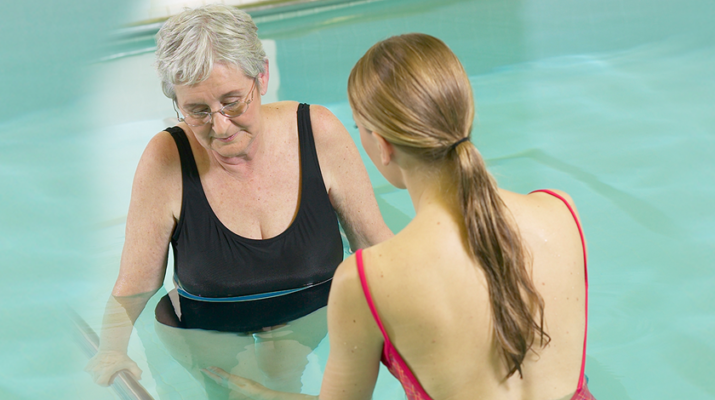By Deborah Jeanne Sergeant
For people recovering from an injury or joint surgery, aquatic therapy may be helpful in getting better sooner. Like land-based (“dry”) physical therapy, aquatic therapy does not require a physician’s prescription and most insurers cover treatment for a total of 30 days. At that point, a prescription would be required.
“Aquatic physical therapy allows people to do things sooner than they may be able to tolerate out of the water,” said Mandy Downs, physical therapy assistant at Lattimore Physical Therapy in Rochester.
She explained that the water’s buoyancy “lightens” the patient, so less weight is placed on a joint. The 94- to 95-degree F temperature of the therapy pool also helps keep patients comfortable.
Lattimore uses aquatic therapy to work with pain in the back, hip, knee, ankle, shoulder and neck.
“Water can be used to assist movement or resist movement, depending on the speed and the direction, and positioning you’re moving it through the water,” Downs said.
She sometimes uses devices in the pool like noodles and flotation boards to help with movement or to encourage patients to stretch further and challenge themselves.
Most therapy pools are relatively shallow, as they’re not meant for diving or swimming laps. Some offer windows on the sides so therapists can see the patients’ movements without the distortion of looking through the water. Some have an optional current to help patients improve balance, strength and range of motion. Benches in the pool can allow patients to perform seated exercise.
Unlike land-based exercise, the pool challenges their posture, balance and core strength. But the water reduces risk of falls.
“It definitely creates that ambient relaxation,” Downs said. “When people are in pain, that’s often the first thing in their mind: they want that pain to go away. If you provide an environment that can do that, they’ll start to relax.”
The water can help people who are obese, experience low back pain or have arthritis to better address their physical therapy needs.
“You can do anything in the pool that you can on the land, but the offloading is beneficial to patients,” said Melanie Kehoe, doctor of physical therapy at Genesee Valley Physical Therapy in Webster.
The water also helps patients who have cerebral palsy, multiple sclerosis or impairment from a stroke if land physical therapy is too challenging.
In addition to rehabilitation, Genesee Valley Physical Therapy offers “prehab” in anticipation of joint replacement surgery to help patients build strength without as much pain.
“It’s been shown to improve outcomes,” Kehoe said.
People with fibromyalgia often see improvement in their ability to move.
“Fibromyalgia patients don’t necessarily think of aquatic physical therapy as a first line thought as far as treatment,” Kehoe said.
The same goes for people who want to start exercising but feel that traditional exercise is too hard because of chronic joint pain and fear injury.
Physical therapists offering aquatic therapy take continuing education credits to learn how to apply physical therapy principles in the water.
Few conditions contraindicate aquatic physical therapy.
“If you have an open wound, you wouldn’t want to get in the water,” said Kali Spoto, owner and physical therapist at Star Physical Therapy in Fairport. “Or someone fresh out of surgery. It’s at least six weeks because of risk of infection. Certain conditions, like neurological if you’re sensitive to heat. That can be a concern.”
Patients should ask their primary care providers about any concerns.

